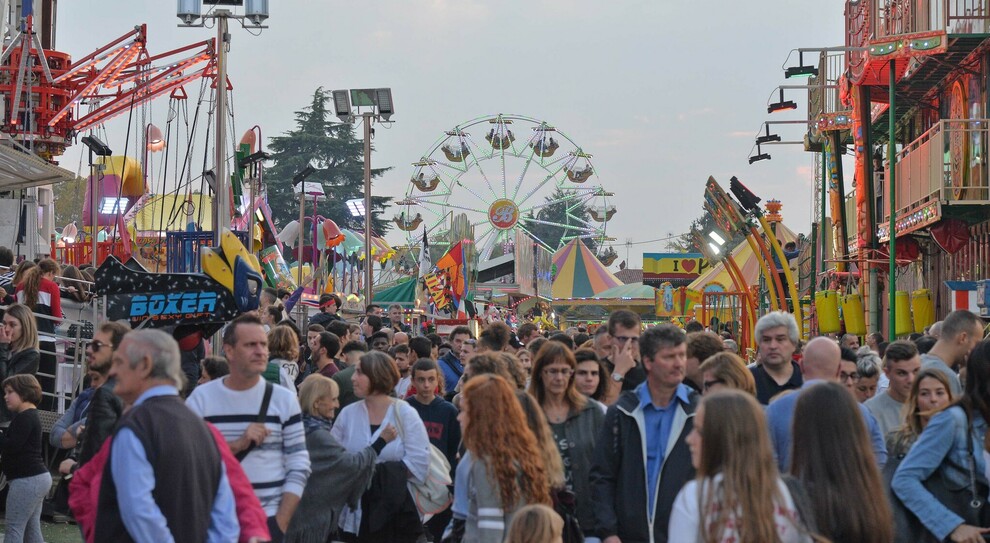In October the city of Treviso hosts a large amusement park for two weeks of fun which will culminate on St. Luke’s Day (18 October). The fair dates back to the 10th century although it only took place regularly from 1205. It was the most solemn and festive annual event in the city: it was in fact a sample exhibition that involved all of North Eastern Italy, so much so that special auctioneers were sent in every city in the Triveneto, in Lombardy and in Emilia Romagna. Originally it took place in September and was called S. Michele di Melma, in homage to the place where it was born; the date and place changed when the Treviso municipality wanted to honor with this festival one of its compatriots who ascended to the papal throne under the name of Benedict XI.
Today the activities linked to commercial exchanges no longer exist, but it remains an opportunity to taste the new wine and to taste the specialties of the season (“folpi”, chestnuts, roast goose with celery, crispy etc.) and to entertain adults and children.
For the inhabitants of Sant’Ambrogio di Fiera, in the immediate outskirts of Treviso, near the Sile River, the San Luca Fairs are an extremely natural event that is part, we can say, of their very lives. The history of Fiera has always been intertwined with that of trade fairs: it would not be possible to imagine one without the others. The obvious confusion caused by the influx of many people that they bring with them every year perhaps causes a certain discomfort to those who live around the large meadow or in its vicinity. But those people know well that Fairs are inevitable; they realize, more or less consciously, that they constitute a historical and customary heritage that cannot be renounced. Therefore, at the beginning of October, when the first autumn mists appear, they prepare to welcome them with serene resignation.
Currently the Fiere di S. Luca present themselves as a grandiose festival, full of attractions for children and adults. But in the first centuries of their history, that is, in the Middle Ages, their appearance and importance were very different. In fact they were essentially a market, a large and famous annual market, where sellers and buyers, even from distant countries, met to exchange products of all kinds.
The origin of the fair, as a commercial institution, is very remote. The custom of holding fairs and markets was also known by the Romans, the Greeks and other even more ancient peoples. However, it was in the Middle Ages that the fair reached great importance. Its affirmation and rapid diffusion in many regions of Italy and other European countries were determined by the general recovery that occurred in the Western world after the year 1000. The great historical value of the fair lies in the fact that it favored the transition from the closed economy, typical of feudal society, to the new city economy, open to free trade between traders from near and far.
The fair was held in the most important places of the city, generally in churches or sanctuaries; it took place coinciding with particular religious holidays and often lasted many days. It was therefore inevitable that it went beyond its purely economic character to take on the appearance of a great popular festival. In this important event, which mostly took place annually, economic interests and religious and folkloristic aspects of the life of the people converged. Thanks to its considerable importance, which also translated into considerable revenue for the public administration coffers, the fair met with the favor and protection of those in power. Special rules and statutes were issued to guarantee the safety of all those who wanted to participate, to regulate the behavior of traders and the sale of goods and to quickly resolve, in the place of the fair, any disputes or arguments that inevitably arose.
Like the fairs of many cities in northern Italy, even that of Treviso, favored by its particularly happy location, reached a dimension of great importance. According to some scholars, first of all the Marchesan, it existed even before the year 1000 and was held on the banks of the Sile, near the city’s port. It is not possible to know how often it took place, what its characteristics were and its duration in that distant era. Barely a hint is contained in the first document that testifies to its existence. This is a diploma from Berengar I, king of Italy, drawn up in Verona, in the church of S. Zeno, on 9 January 905. With this diploma the King granted the Bishop of Treviso, Adalberto, several rights, including two thirds of the taxes due to him on the “Port Trevigiano market”. With this concession the Bishop came into possession of the entire benefit of the Fair, because the other third of the taxes had already been ceded to the Treviso Church by Bere’s predecessors




